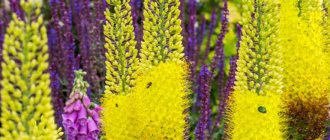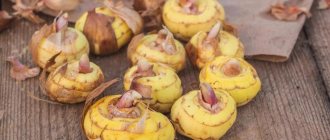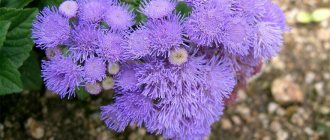This article will talk about how to grow chrysanthemums, when they need to be planted, and how to care for them in open ground. Despite the fact that the flower is unpretentious, it is still necessary to care for it. You also need to know some secrets for growing it. Further details.
Chrysanthemums are royal autumn flowers. They bloom with the onset of cold weather. There are different types of these luxurious flowers. Some varieties of chrysanthemums have a more hardened character, while others cannot boast of particular durability. Some specimens grow and bloom until December frosts. In addition, chrysanthemums look beautiful in bouquets and are stored in this condition for a long time. They can be stored cut for a month. But further we will not talk about the endurance of these flowers, but about how to grow a chrysanthemum, how to properly care for flowers, when it is necessary to plant them in open ground, and how to water them correctly.
Chrysanthemums - flower description
There are perennial and annual types of chrysanthemums, herbaceous and subshrubs. The shoots of chrysanthemums are always hard and straight, the leaves are arranged alternately.
Conventionally, all chrysanthemums can be divided into two types - large-flowered
(Indian) and
small-flowered
(Korean).
Large-flowered chrysanthemums
can only be grown in southern regions, greenhouses or conservatories - they are afraid of frost.
Korean chrysanthemums
They look very compact and beautiful.
Chrysanthemum is not a plant for lazy gardeners, as it requires constant care.
To obtain lush flowering of chrysanthemums, you need to water, feed, shape in time, divide, and take cuttings.
How to use chrysanthemums in garden design?
Chrysanthemums are one of the most elegant autumn flowers. Bright balls of chrysanthemums in combination with colorful autumn foliage of trees and shrubs in the midst of falling asleep nature look truly precious luxury!
These wonderful plants can be used as a separate flower bed or combined with other autumn-flowering plants (asters, sedums, rudbeckias). The bright inflorescences of chrysanthemums next to a variety of grains look very original and elegant.
Take the opportunity to extend the lush flowering of your garden until winter! And let chrysanthemums give you joy and a festive mood!
Chrysanthemums - growing from seeds
The easiest way to propagate chrysanthemums is by dividing bushes and cuttings, but chrysanthemums are often grown from seeds.
When the threat of return frosts has passed, in May, chrysanthemum seeds are sown in open ground. The distance between plants is 20-25 cm. Make small holes, pour water and put 2-3 seeds in each, sprinkle with earth.
To preserve heat and moisture, cover the bed with film, which is removed as soon as the first shoots appear.
10 days after germination, feed the seedlings with complex mineral fertilizers. Remove weeds from the garden bed in a timely manner and loosen the soil after rains and watering.
When the seedlings are 7-10 cm tall, leave 1 seedling in each hole; the remaining shoots can be transplanted to another place. Such annual chrysanthemums will bloom in August. In order for flowers to appear earlier, it is necessary to grow chrysanthemums from seeds through seedlings.
Types and varieties
Despite the outstanding successes of breeders in developing new species and varieties of chrysanthemums, there is still no unified classification system for these plants. In Germany, France and China they are divided into 10 classes, and in England and America - into 15. We will introduce you to several, in our opinion, more successful.
Classifications based on flower size and bush height:
Chrysanthemum grandiflora
Luxurious large chrysanthemums (flower diameter 10-25 cm, average height 80-120 cm) of different shapes of inflorescences, grown mainly for cutting. Most often, this type of chrysanthemum does not overwinter in open ground, but recently varieties have been developed that can be left in the garden for the winter:
- Anastasia Green – green needle-shaped chrysanthemums, bush 80-100 cm tall, blooms from October, overwinters in the ground, but requires shelter;
- chrysanthemum Zembla Lilac - very large double pink chrysanthemums, wide petals, bush height 90 cm, winters in the garden. The Zembla series potted forms are very popular;
- Tom Pierce - red chrysanthemum, the reverse side of the petal is orange, the shape of the flower is spherical, diameter - 22 cm, bush height - 150 cm, blooms from September;
In the photo: Chrysanthemum grandiflora Anastasia Green
Chrysanthemum medium-flowered
It is called decorative. The diameter of the flowers is 10-18 cm, the height of the bushes is 30-70 cm. It is grown not only in the garden, but also in pots, decorating balconies and terraces with them. Can also be used for cutting. Here are the varieties that grow well in the garden:
- Splash of champagne - bush chrysanthemum, bush height - 70-90 cm, needle-shaped inflorescence of light pink color with a yellowish coating in the center, there is a variety with golden flowers, diameter 8-10 cm. Blooms from October until frost, overwinters well in the ground;
- Golden Fleece - yellow-orange chrysanthemum, height - 40-60 cm, blooms from the end of September, winters in the garden;
- Pink chamomile is actually a dark pink chrysanthemum daisy, the diameter of the flower is 6-8 cm, the height of the bush is 60-90 cm. It blooms in September and blooms until frost, overwinters in the ground.
In the photo: Chrysanthemum grandiflora Tom Pierce
Small-flowered chrysanthemum, or Korean chrysanthemum
Frost-resistant perennial chrysanthemums, popularly called “oaks” for the shape of the leaves, which are similar to oak leaves. Bushes 25-120 cm high, numerous inflorescences, both simple and double, of various colors. Easy to care for, reproduces well, grows in any soil for up to 4 years. It blooms in mid-September and blooms until frost. Inflorescences with a diameter of 2 cm to 10 cm. The aroma of these chrysanthemums resembles the smell of wormwood. They winter well in open ground:
- Etna - a bush 60-80 cm high, lilac needle-shaped flowers with a diameter of 6-8 cm, blooms from October;
- Slavyanochka – 40-60 cm tall, pink chrysanthemums with a bright center, blooms from the end of September;
- Multiflora is a new selection of chrysanthemum that has become incredibly popular lately. It can be grown both in open ground and in a container or pot. It blooms early, sometimes even in August, has a spherical bush shape and a wide range of colors.
In the photo: Medium-flowered chrysanthemum Pink chamomile
Classification according to the shape of the inflorescences:
Simple chrysanthemums
- non-double (Ben Dickson, Pat Joice);
- semi-double (Amazon, Baltika, Natasha;
- anemone-shaped (Vivien, Beautiful Lady, Andre Rose).
In the photo: Chrysanthemum medium-flowered Multiflora
Terry chrysanthemums
- bent (Regalia, Tracy Waller);
- flat (Swan Song, Valli Ruf);
- hemispherical (Gazella, Zlata Praha, Trezor);
- spherical (Arctic, Kremist, Broadway);
- radiate (Pietro, Magdalena, Tokio);
- pompons (Denis, Fairie, Bob);
- arachnids (Spring dawn on the Su-Ti dam, Gratsia).
Classification by flowering time:
Early varieties
- chrysanthemum Zembla yellow - yellow large-flowered chrysanthemums of spherical shape, diameter 15 cm, blooms from September;
- Deliana - white, needle-shaped chrysanthemums, 16 cm in diameter, bloom in September;
- Handsom - lilac-colored daisy chrysanthemums with a white border. Blooms from September;
Medium flowering varieties
- Orange – spherical chrysanthemums, bright yellow, 20 cm in diameter, bloom in October;
- Anastasia lil - needle-shaped lilac flowers 20 cm in diameter. They bloom in October;
- Froggies are small, spherical green flowers that bloom in October.
Late varieties
- Avignon - spherical flowers 20 cm in diameter, light pink, blooms from November;
- Rivardi - yellow balls 20 cm in diameter, bloom in November;
- Larisa - white daisies with a yellow center, the beginning of flowering is November.
In the photo: Chrysanthemum Zembla yellow
In addition, chrysanthemums are divided into annuals:
Chrysanthemum keeled, or tricolor
Densely branched, height 20-70 cm, fleshy stem, leaves petiolate, twice pinnately divided, inflorescences - large baskets, simple, semi-double or double, 5-7 cm in diameter. Reed flowers are white or yellow with a reddish edge, tubular flowers are dark red. Varieties:
- Flammenstahl – yellow-brown center, red flowers;
- Nordstern - large white flowers with a yellow-red center;
- Cockade - simple white flowers with a carmine base bloom in June and bloom until September;
In the photo: Chrysanthemum Orange
Chrysanthemum field, or sowing
Height 30-60 cm, branches well, leaves at the bottom of the stem are pinnate, at the top - serrated. The flowers resemble field daisies, white with a yellow center, 3-5 cm in diameter. Popular varieties:
- Helios – golden yellow chrysanthemums;
- Stern des Orients - light yellow flowers, dark center;
In the photo: Chrysanthemum Froggy
Chrysanthemum crown
Tall (40-100 cm), shoots are densely leafy with pinnate divided leaves, there are areas of serrated, lanceolate leaves. Inflorescences are up to 3 cm in diameter, the color of tubular flowers is yellow-green, the color of reed flowers is from yellow to white.
- Tetra comets – semi-double, large-flowered variety of various colors
...and perennial chrysanthemums,
which include almost all of the above-described species and varieties.
There is also Scott's classification of chrysanthemums, created in 1951. Among flower scientists it is considered detailed and convenient, but for amateurs it is complex, so we will not waste your time.
Planting chrysanthemums in spring
Chrysanthemum seedlings are planted in the spring, when the threat of return frosts has passed - late May, early June.
The area for planting chrysanthemums should be well lit by the sun, without constant drafts and stagnant water.
Neutral or slightly acidic, loamy, nutritious soil is suitable for growing chrysanthemums.
Chrysanthemum does not like unrotted manure; it prefers vermicompost or compost, which is added to the planting hole.
It is better to plant in the evening or on a cloudy day, keeping a distance of 50 cm between plants - it all depends on the variety and type.
After planting and watering the plants, pinch, removing the top part (growing point) of the chrysanthemum. It is better to cover the seedlings with covering material to create a microclimate and better survival rate.
Where to plant chrysanthemums
Almost all flower growers know how to grow chrysanthemums and how to plant them in the garden. However, few people think about planting rules. The main thing is to provide the plant with at least three hours of sunlight daily, so a shaded area is not the best option for planting. The place should be open on all sides.
You should not choose for planting areas with dry peaty or sandy soil, poor in minerals. Another requirement for soil is a good ability to retain moisture. At the same time, the water should not stagnate.
The plant will develop best if placed on light sandy loam soils. If the soil is rich in organic matter and humus, the chrysanthemum will take root well and will delight you with its lush blooms for a long time. Also, the soil must drain well.
This flower does not like sudden temperature changes, wind and lack of sun.
Experts do not recommend planting these flowers for more than two or three years in a row in the same area - this can cause problems such as degeneration of the variety, damage by viral and fungal infections, and invasion of parasites.
If chrysanthemums are planted in soil poor in nutrients, the situation can be saved by regular fertilizing. It is much more difficult to solve the problem of wintering (most varieties do not tolerate even the slightest frost). In case of high soil moisture, watering must be reduced, this will prevent rotting of the roots.
Propagation of chrysanthemums by cuttings
A simple way to propagate chrysanthemums is by cuttings. In the spring, when the daytime temperature is 22-26 degrees, use a sharp knife to cut cuttings from the mother plant (growing directly from the root of the chrysanthemum, and not lateral shoots). The length of the cutting should be 6-7 cm.
The substrate for planting cuttings must be prepared in advance.
The lower part of the cutting is dipped in a growth stimulator and planted in a container with nutrient soil, which is covered with sand to a depth of 12 cm, at an angle of 45 degrees.
The bottom of the cutting should remain in the sand without touching the soil. The cuttings are placed and rooted on a light windowsill, making sure that the soil is constantly moist. The temperature when rooting cuttings should be 15-18 degrees.
After 2-3 weeks, the cuttings form roots and can be planted in open ground.
Chrysanthemums - planting in open ground
Chrysanthemum flowers with their beauty can decorate a garden plot and veranda. They can be grown in open ground, or in pots. Chrysanthemums look amazing and have a bright color. They are not particularly afraid of cold weather. The plant can be perennial or annual; if you plant it in a flowerbed, you are guaranteed to have a flowering season that lasts until the December frosts. How to grow a chrysanthemum in detail, see below.
Autumn chrysanthemums
How to plant flowers in open ground? Flowers can be planted in open ground in spring and autumn. But the process is significantly different. Gardeners claim that in the open ground it is in the spring that cuttings and queen cells take root better; in the fall they take root worse. But in the fall, you can plant a ready-made flowering shrub in the ground; you will clearly see what type of chrysanthemum you planted in your garden or flowerbed.
If we talk about the most frost-resistant varieties of chrysanthemums, then small-flowered Korean chrysanthemums are among the most frost-resistant. They are also called oak trees. Among the most beautiful, tall ones are the Indian large-flowered ones, they grow up to one and a half meters tall and look wonderful. The only drawback is that they are afraid of cold weather.
Chrysanthemums in autumn
Methods for planting chrysanthemums in open ground:
- Flowers are planted by seeds. This method should be used to plant chrysanthemums in the spring, already in warm soil, preferably in May. When the seedlings grow ten centimeters, they will need to be pinched. And in the fall such flowers will begin to bloom.
- Chrysanthemums are propagated by cuttings . If you cut a cutting from picked flowers, it will sprout in the soil. To speed up the growth of the cutting, it is rooted in soil consisting of sand and peat. It is advisable to initially keep the cuttings under glass in a cool place; when the roots appear, they are transplanted into a pot. And in the spring they are planted in open ground.
- You can plant a mother plant in the spring - it is the overwintered root of a flower. It is from the mother plant that the shoots come. Queen cells are sold on the market in the spring. They are planted in the soil when it gets warmer.
- By dividing chrysanthemum bushes you can plant the plant in the fall. To do this, the flower is carefully dug out of the soil, the rhizome is separated with pruning shears, after which it can be immediately planted. This process should be carried out once every two years to rejuvenate the flowers.
The ideal weather for planting chrysanthemums in the ground is cloudy. And it will be another plus if the weather was rainy outside the day before. Light rainfall for chrysanthemums and moist soil during planting are a favorable environment.
Garden chrysanthemums
It is better to dig a trench for the plant rather than a hole. To prevent the flower from rotting in the future, plant it at the level of the shoot growth point. It is carefully placed in the trench, after which it is buried in soil. Finally, chrysanthemums should be watered generously. It is recommended to wrap young chrysanthemums in sawdust to prevent them from freezing; if such material is not available, then foliage from trees will do. This way you will create favorable conditions for rooting.
IMPORTANT: Before planting chrysanthemums, fertilize the soil. You can use sand with humus, and to ensure long-term flowering for chrysanthemums, add ash (3 cups) and 55 grams of nitrophosphate, which can be bought in seed stores. Or fertilize with humus (five kilograms of humus are poured onto one square meter of soil).
Planting chrysanthemums in open ground in spring
Thanks to fertilizer, the stems of the plant will be stronger, grow faster, and cut flowers will last longer. And phosphorus microelements will enhance flowering. That is why flowers are planted only in fertilized soil. Select an area for planting that is elevated, this way you will avoid excessive moisture. If sunlight rarely falls on the plant, then the flowers will bloom much later than on the sunny side.
Also, do not choose too open spaces for chrysanthemums, where it will be very windy. This way you will have confidence that the chrysanthemum bushes will grow well, branching will begin on time, and the chrysanthemums will not freeze in winter. Chrysanthemums do not tolerate stagnation of water in the root system. This is perhaps the biggest weakness of flowers. Also, like many plants, it is important for chrysanthemums that the soil is fertile and enriched with air. The acidity of the soil should be neutral. In extreme cases, slightly acidic soils are also suitable. If you have clay or sandy soil, then add organic matter; you can also add store-bought fertilizers from a complex of useful ingredients.
Chrysanthemums, planting in open ground
Seedlings are planted in the ground in the spring after frost or in the fall before the onset of frost. Plants are planted at a distance of 45 centimeters from each other. You can speed up the growth of flowers using Kornevin. Afterwards, the seedling should be pinched, then the flowers are covered with a special covering. You can remove the material when the seedlings gain growth.
Caring for chrysanthemums
For normal growth and abundant flowering, it is necessary to follow some rules when caring for orchids.
The main task is to pinch the seedlings in time, after the appearance of the 8th leaf, then do the same when side shoots appear. This will increase the branching of the plant, and it will take on a beautiful ball shape.
When growing large-flowered chrysanthemums, you need to do the following: on the main stem, it is better to remove the side shoots completely, leaving a few of the strongest ones.
Tall varieties of chrysanthemums
need tying; for this, various structures are used to hold the bush or a regular peg is used.
Chrysanthemums need abundant watering, otherwise the stems become woody and the flowers less attractive. Watering should be done only at the root.
Loosen the soil around the bushes and remove emerging weeds.
Chrysanthemums need feeding, the number of which should be at least 3 per season. The first feeding is carried out 6 weeks after planting, the rest at intervals of 3-4 weeks.
At the beginning of growth, it is necessary to apply more nitrogen-containing fertilizers for active growth and growth of green mass. At the beginning of bud formation and during flowering, chrysanthemums need phosphorus-potassium fertilizers more.
For organic fertilizers, you can use rotted cow manure or bird droppings.
Classification of chrysanthemums
Chrysanthemums in the country are classified according to flowering time. They are early, medium, late, winter-hardy. Each individual species requires compliance with certain rules in cultivation.
Early varieties
They begin to bloom in June. They reach a height of 1.5 m. They are solitary or shrubby. The sizes of their buds vary from small to large.
Popular varieties:
- Anita . White single flowers in the shape of a ball. The diameter of the buds reaches 20 cm;
- Monagua . The flowers are red, small, resembling daisies;
- Regalia . Varieties with medium-sized buds, red color.
Medium varieties
The buds open in July. The stems are erect, up to 1 m high. Typically, such chrysanthemums are classified as shrubs with a beautiful spherical crown.
Among the popular varieties it is worth highlighting:
- Anastasia;
- Kazan;
- Viking.
Late varieties
They bloom in August. The height of the stem of late varieties varies from 1 m to 1.6 m. These chrysanthemums grow quickly and form lush bushes. Their stems are dense and strong, which can easily cope with strong winds and hail.
A feature of late chrysanthemums is that their flowers are located on the same level. Therefore, in flower beds they look like lush and elegant bouquets.
How to preserve chrysanthemums in winter
Heat-loving large-flowered varieties are afraid of frost and do not disappear in winter. Such varieties are usually dug out of the ground before frost (by selecting the mother bushes), placed in wooden boxes and stored in a cool room with a temperature of 2-6 degrees until spring.
Chrysanthemums are watered occasionally to keep the lump of earth moist.
Place for planting garden chrysanthemums
Many people are interested in how to plant chrysanthemums? This plant is completely unpretentious to the type of soil and planting site. It feels equally good in the sun or in partial shade. But in the shade, the plants stretch out, do not bloom as profusely, and their inflorescences lose their lushness.
Attention: not all varieties of chrysanthemums can withstand high humidity, and some of them cannot tolerate shade.
Annuals are best planted at higher elevations. But keep in mind, these flowers do not stay in one place for more than 3 years. Otherwise, they will suffer from various diseases associated with damage and rot of the root system.
Chrysanthemum diseases
Chrysanthemums can also be susceptible to various fungal diseases if the basic rules of agricultural technology are not followed:
- Powdery mildew affects leaves, shoots, buds, flowers and covers them with a white coating.
- Verticillium wilt, leading to yellowing of leaves and death of stems.
- rust, the above-ground parts of plants become covered with chlorotic spots that turn brown over time, resulting in yellowing of the leaves.
- gray rot leads to the appearance of brown spots, which over time become covered with a fluffy coating, which causes rotting of the plant.
Preparations containing copper can help in the treatment of fungal diseases - copper oxychloride, Bordeaux mixture, colloidal sulfur
.
Chrysanthemums are sometimes affected by viral diseases that are incurable and such plants must be promptly destroyed.
To exclude the possibility of infection with viral diseases, always use sterile instruments when cutting chrysanthemums.
Features of chrysanthemum
Chrysanthemums are represented by perennial or annual subshrubs and herbaceous plants. The branched rhizome grows parallel to the soil surface. The surface of the stems may have pubescence, but they may also be bare. Simple alternately arranged bare or pubescent leaf plates differ in size and shape: jagged, notched or dissected. As a rule, the foliage is greenish in color, but it can also be dark green. Most often, small flowers are part of an inflorescence-basket, which in some cases can be quite large. The basket consists of single-row reed-shaped marginal and central tubular flowers, but in most hybrid varieties they are arranged in multi-rows, resulting in the formation of a lush inflorescence called terry chrysanthemum. The fruit is an achene. Today, gardeners cultivate varieties and species of the so-called mulberry chrysanthemum, or garden chrysanthemum. It is also sometimes called Chinese chrysanthemum. This group of varieties and hybrids is very complex, and they also have a complicated history.
Chrysanthemums. Features, care and reproduction
Pests of chrysanthemums
Nematodes most often cause damage to chrysanthemums - the appearance of mosaic spots on the leaves. Such plants must be removed from the site and destroyed. As a preventive measure against nematodes, before planting or digging up plants, treat them with Phosfamide solution.
Aphids are a pest of chrysanthemums, settling on the lower part of the leaves or in the buds, sucking the juice from the plants, inhibiting its growth and flowering. Infected plants must be treated with Aktara or Aktellik.
Slugs pose a danger to chrysanthemums; they can eat leaves, stems, and flowers.
Read more:
How to deal with slugs?
How to deal with diseases and pests?
Chrysanthemums often feel unwell as a result of errors in planting and care. This may be insufficient watering, poorly chosen site or improperly prepared soil.
If your chrysanthemum is “sad” and shredded, transplant it to another place. The most dangerous pests are aphids and spider mites. To kill aphids, wash the plant with soapy water, repeating the treatment every 7-10 days. Treating plants with a pyrethrum solution gives good results. We prepare it like this: infuse 200 g of pyrethrum powder in 10 liters of water for 12 hours. Then take 50 ml of infusion, dilute it in 10 liters of water and add 50 g of soap. An infusion of garlic will also help in the fight against aphids and spider mites.
Take 50 g of garlic, grind it in a mortar and pour a glass of cold water. After 15-20 minutes, filter the mixture and dilute with water, bringing the volume to 1 liter. Pour one and a half glasses of this solution into a bucket of water. In the evening or in cloudy weather, carefully wash the chrysanthemum bushes.
Chrysanthemum is an amazing plant that can itself serve as an excellent insecticide. It helps a lot in the fight against such an indestructible garden “monster” as the mole cricket. The secret is that chrysanthemum flowers and leaves contain a special essential oil with a specific smell. The mole cricket and many other garden pests hate it! Therefore, a wilted bouquet of chrysanthemums, which has already served its time as a decoration, will be very useful to us. We hang it up to dry completely, and then grind it. The resulting powder is added to the soil when planting vegetables, such as tomatoes. The mole cricket will not even come close to such a bed! And our seedlings will be reliably protected from pests!
The process of replanting chrysanthemums in autumn
In the fall, bushes are also replanted:
- Dig a hole 40 cm deep.
- Lay out a layer of drainage and fertilizer.
- Dig up a bush. If the soil is dry, water it at the root. Pull it out together with the earthen lump.
- Cut off the roots of the transplanted bush by 20-30 cm in circumference. The plant will begin to form new roots, due to which it will take root better.
- Pour Kornevin solution and a little water into the new planting hole.
- Place the bush inside.
- Sprinkle with soil and water generously.
It is recommended to replant the plant at the same time as planting.
The best garden chrysanthemums: planting and care in the garden or flowerbed
First of all, you need to understand that caring for garden chrysanthemums begins with planting, since it requires a special place, as well as soil. It is best to choose a slightly elevated place where water will definitely not accumulate. The soil should be loose, not clogged, with good drainage capabilities. In addition, the place must be sunny or slightly darkened, but never shady, otherwise your flowers will stupidly stretch their stems upward, and flowers may not appear on them at all.
- For planting, it is better to buy special soil, which, by definition, will be quite hygroscopic and also loose. You can pre-mix the soil with peat and gravel, the main thing here is not to overdo it, so that the nutrients for the flower remain in it, because this, after all, is far from a cactus, which only needs to be watered once every six months.
- Chrysanthemum does not like excessive watering, because the roots can rot. But excessive drying should also never be allowed. This flower has a superficial root system, and if there is a lack of moisture, it will first become dry, its leaves will turn yellow and curl, and subsequently the plant may die altogether.
- For transplanting and planting, it is best to choose rainy or even cloudy weather to make it easier for the plant to withstand stress.
- The hole is made from twenty-five to forty centimeters, depending on the size of the rhizome, it is spilled generously with pre-settled water, after which drainage is laid on the bottom. For example, washed and coarse river sand is perfect.
After planting, the chrysanthemum should only be lightly sprinkled with soil; there is no need to deepen it excessively, since the soil must be compacted with great care. For tall varieties, it is better to immediately provide support, in the form of a garden trellis, or even simply a buried beautiful twig
It is necessary to carry out pinching immediately after planting, and then, after about fifteen twenty days. This will not only allow the correct shape of the chrysanthemum crown to be formed, but will also lead to denser growth of young shoots with inflorescences. After the plant has completely taken root, all that remains is to figure out how to care for the garden chrysanthemum so that it will delight you for a long time with fragrant pom-poms of flowers.
Important
After planting chrysanthemums, it makes sense to shade them somewhat and protect them from the bright sun, since the plant is already under stress. The easiest way to do this is with the help of a special garden non-woven material. Here you need to strictly ensure that your “roof” does not touch the stems and leaves, as this negatively affects overall growth. The easiest way is to build a kind of box frames from thin planks, upholstering them with appropriate fabric.
How to care for chrysanthemum seedlings
To get quick and friendly shoots, strong and strong seedlings, the plant should be provided with comprehensive care, which includes regular watering, maintaining an optimal level of humidity, lighting, and temperature conditions.
How to care for chrysanthemum seedlings is described in more detail below:
After planting, you need to immediately create a mini-greenhouse. To do this, be sure to cover the container with a lid, glass or film. Before emergence, ventilate daily for 20 minutes, slightly opening the covering material, and also wipe off condensation from it.
The soil before and after emergence should be moderately moist, but it should not be flooded. Excessive humidity can provoke the development of fungal diseases. Before emergence, water only with a spray bottle! And then you can use a syringe or syringe.
- After germination, you need to transfer the plants to a sunny windowsill. In the morning and evening, seedlings should be illuminated, since the optimal length of daylight hours is 12-14 hours.
- Also, after germination, you need to gradually remove the film or cover. On the first day, ventilate for an hour several times, on the second and third days, gradually increase the ventilation time, and then remove the covering material forever.
- After emergence of seedlings, the temperature drops to +16-18°C.











